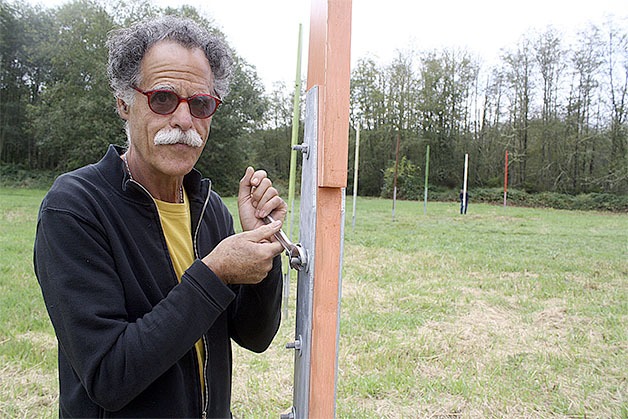It was intended as a short-term creation—and it will be, in the grand scheme—but the art work to be dedicated at 10 a.m., at Meadowbrook Farm Saturday, Sept. 27, is too timeless to be temporary.
Begun as a site-specific installation funded by King County’s 4Culture, the Mary Louie Project, with its interplay of local history and culture and natural beauty, held such appeal for the Meadowbrook Farm board, artist Don Fels said, that board members asked him to make it permanent.
“It was just supposed to be up for a couple weekends,” said Fels, who created the piece with former North Bend museum curator Kenneth G. Watson and Sammamish arts advocate Barbara Jirsa.
“That’s the nature of site-specific work. But the Meadowbrook Farm people liked the idea so much, they said ‘but what if we don’t want to take it down?’”
So Mary Louie, a Snoqualmie healer who probably visited Meadowbrook Farm to gather herbs or to visit family members working as hop-pickers during her life, now has a semi-permanent home there.
“All the piece consists of is this very large arc (of colored cedar planks) and a rock that you can sit on and contemplate the changing of the seasons,” said Fels. That, and the history of the Valley from the early 1800s, when Mary Louie was believed to be born at Lake Sammamish, to the early 1900s.
“No one knows exactly when she was born, but it’s claimed that she was 120 years old when she died,” said Fels, “or she was 115, or she was 110. I think it’s pretty safe to say she was old.”
For much of her life, Mary was a medicine woman and midwife. “She travelled by canoe and was a helper of various people in distress, and one of the things she helped with was delivering babies,” Fels said. “She inherited a tradition of medicine based on plants, which is ancient, ancient tradition.”
So the creators were fairly certain that she’d have visited Meadowbrook, the largest meadow around and a gathering place for Snoqualmies and other tribes, to harvest or trade for medicinal plants she could find nowhere else.
“We have no absolute proof that Mary Louie went there, but there’s no way she wouldn’t have,” Fels said, based on her work as a healer. “We are conjecturing… this is sort of creative non-fiction here!”
The farm was an obvious location for an installation, even before their first site selection fell through. The Mary Louie Project was originally destined for Lake Sammamish, her birth place, until a construction project that would close the trail for nine months was announced. The move to Meadowbrook was easy.
“We’d always wanted to do something at Meadowbrook,” Fels said. Also, “the whole Salish culture is very place-oriented.”
Place became a crucial part of the piece, Fels said, when he found a small clearing, close to but invisible from nearby Boalch Avenue. A blackberry-lined track across Boalch from a small parking area leads to it, he said, “then it opens up into this really lovely meadow, with Mount Si right behind it.”
It was exactly the kind of peaceful setting that Snoqualmie elders would have used to consider decisions before sharing them with the tribe.
“Native people didn’t really have names for the seasons or months,” explained Fels, but planned more according to the natural world — when the salmon were running or the blackberries were ripe, for instance. “The practice was that an elder would go and sit somewhere, and think, watch the sun go up, and determine by sightings what the seasons were….It was all sort of tuned for where you lived.”
To represent this ‘calendar,’ Fels and Watson mounted 11 cedar planks, colored according to some of the native seasons, in a curving line. The seat is a piece of the “swing rock,” from the Snoqualmie legend of how their ancestors came to the area via a rope swing from the sky.
Because so much Snoqualmie history was involved, Fels said, “We got the blessing of the tribe right off the bat, which has been very important to us.”
Both North Bend and Snoqualmie have given their blessings to the project, too, sharing the costs of the metal brackets that Fels designed to make the piece a three-season installation. The planks will remain in place until winter, then taken down and stored, then reinstalled in the spring.
Fels, who works internationally, is pleased to be a part of such a local effort, and is already planning part two of it, for next year at Lake Sammamish.
“It’s not your normal project,” he said of the Meadowbrook installation. “It all came out of the community here… this isn’t a Seattle story, although she worked in Seattle. It’s a Snoqualmie Valley story.”
Learn more about Fels at www.artisthinker.com.
Seth Truscott/Staff Photos

Fels’ Mary Louie Project’s colored posts stretch in a curve across a Meadowbrook field.

Fels and Kenneth Watson, putting finishing touches to the sculptural installation.


Line art of Mary Louie, Snoqualmie healer who lived in the 19th and early 20th centuries. Art by Kenneth Gregory Watson. Below, signs and art explain the work, context and history.


A detail of one of Fels’ standing posts. The shape of the works echo the pattern on woven tribal baskets.


